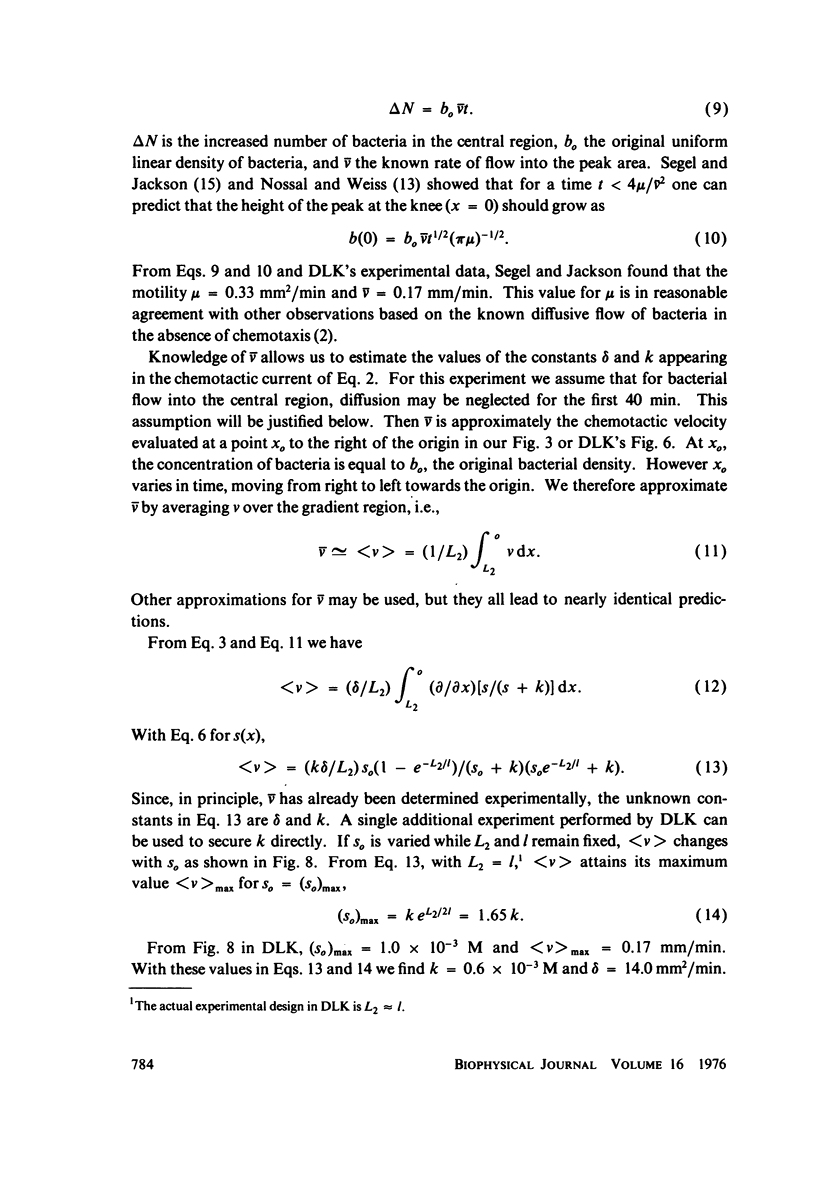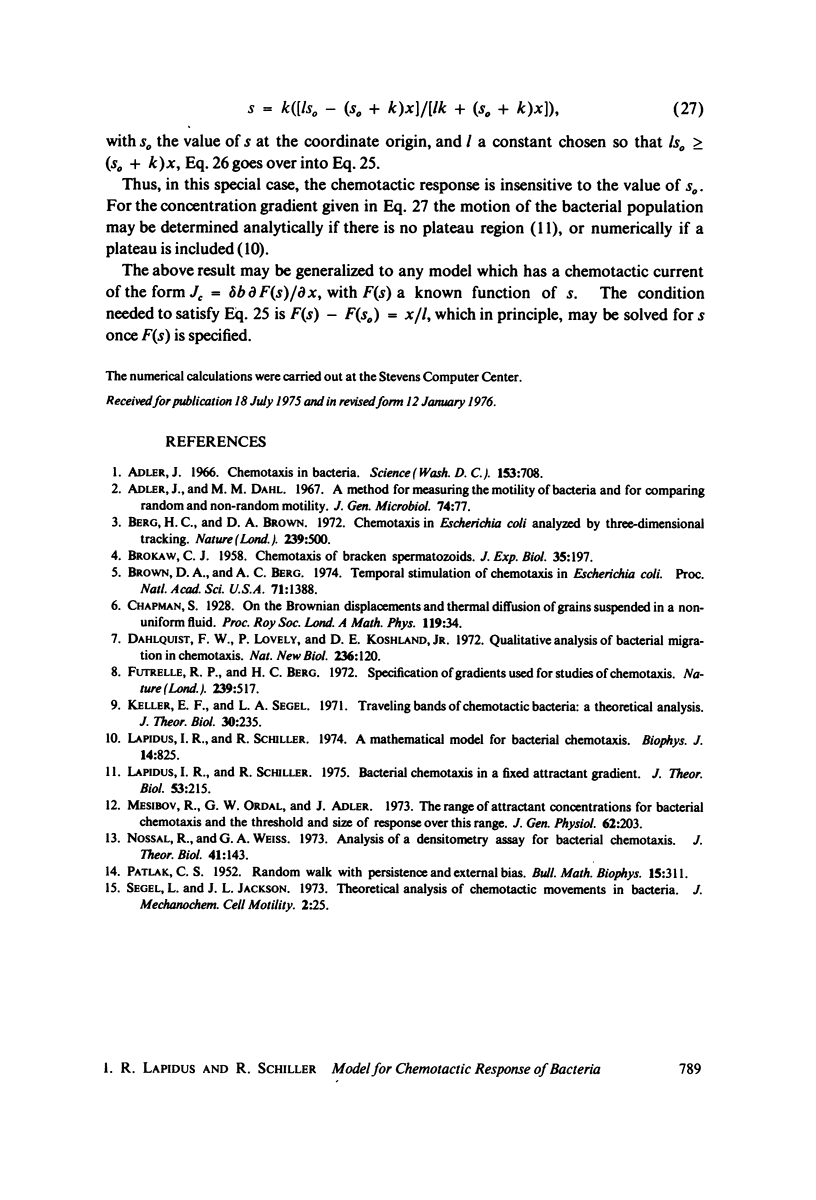Abstract
We present a mathematical model for the motion of a bacterial population in prescribed attractant or repellent gradients. The model is suggested by the observations of Mesibov et al. (1973, J. Gen. Physiol. 62:203) and Brown and Berg (1974, Proc. Natl. Acad. Sci. U.S.A. 71:1388) who found that the sensitivity of the chemotactic response depends on the concentration of attractant. Predictions of the theory are in general agreement with the experiments of Dahlquist et al. (1972, Nat. New Biol. 236:120) and of Mesibov et al. on populations of motile bacteria in fixed attractant gradients. Additional tests of the model are proposed.
Full text
PDF










Selected References
These references are in PubMed. This may not be the complete list of references from this article.
- Adler J. A method for measuring chemotaxis and use of the method to determine optimum conditions for chemotaxis by Escherichia coli. J Gen Microbiol. 1973 Jan;74(1):77–91. doi: 10.1099/00221287-74-1-77. [DOI] [PubMed] [Google Scholar]
- Adler J. Chemotaxis in bacteria. Science. 1966 Aug 12;153(3737):708–716. doi: 10.1126/science.153.3737.708. [DOI] [PubMed] [Google Scholar]
- Berg H. C., Brown D. A. Chemotaxis in Escherichia coli analysed by three-dimensional tracking. Nature. 1972 Oct 27;239(5374):500–504. doi: 10.1038/239500a0. [DOI] [PubMed] [Google Scholar]
- Brown D. A., Berg H. C. Temporal stimulation of chemotaxis in Escherichia coli. Proc Natl Acad Sci U S A. 1974 Apr;71(4):1388–1392. doi: 10.1073/pnas.71.4.1388. [DOI] [PMC free article] [PubMed] [Google Scholar]
- Dahlquist F. W., Lovely P., Koshland D. E., Jr Quantitative analysis of bacterial migration in chemotaxis. Nat New Biol. 1972 Mar 29;236(65):120–123. doi: 10.1038/newbio236120a0. [DOI] [PubMed] [Google Scholar]
- Futrelle R. P., Berg H. C. Specification of gradients used for studies of chemotaxis. Nature. 1972 Oct 27;239(5374):517–518. doi: 10.1038/239517a0. [DOI] [PubMed] [Google Scholar]
- Keller E. F., Segel L. A. Traveling bands of chemotactic bacteria: a theoretical analysis. J Theor Biol. 1971 Feb;30(2):235–248. doi: 10.1016/0022-5193(71)90051-8. [DOI] [PubMed] [Google Scholar]
- Lapidus I. R., Schiller R. A mathematical model for bacterial chemotaxis. Biophys J. 1974 Nov;14(11):825–834. doi: 10.1016/S0006-3495(74)85952-7. [DOI] [PMC free article] [PubMed] [Google Scholar]
- Lapidus I. R., Schiller R. Bacterial chemotaxis in a fixed attractant gradient. J Theor Biol. 1975 Sep;53(1):215–222. doi: 10.1016/0022-5193(75)90112-5. [DOI] [PubMed] [Google Scholar]
- Mesibov R., Ordal G. W., Adler J. The range of attractant concentrations for bacterial chemotaxis and the threshold and size of response over this range. Weber law and related phenomena. J Gen Physiol. 1973 Aug;62(2):203–223. doi: 10.1085/jgp.62.2.203. [DOI] [PMC free article] [PubMed] [Google Scholar]
- Nossal R., Weiss G. H. Analysis of a densitometry assay for bacterial chemotaxis. J Theor Biol. 1973 Sep 14;41(1):143–147. doi: 10.1016/0022-5193(73)90194-x. [DOI] [PubMed] [Google Scholar]
- Segel L. A., Jackson J. L. Theoretical analysis of chemotactic movement in bacteria. J Mechanochem Cell Motil. 1973 May;2(1):25–34. [PubMed] [Google Scholar]


